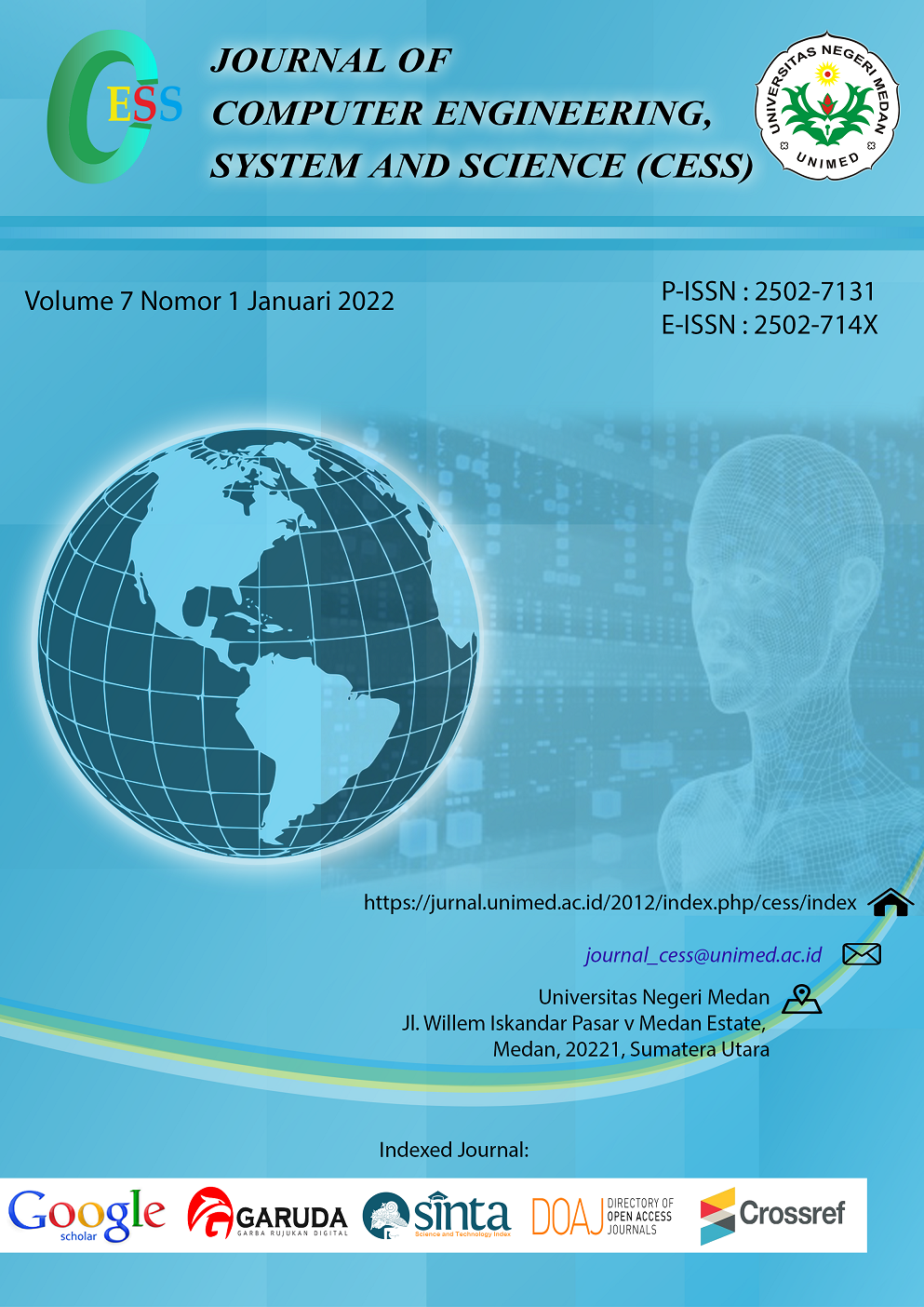Biometric Technology Using Eigenface Algorithm
DOI:
https://doi.org/10.24114/cess.v7i1.28918Keywords:
Biometrik, Pengenalan Wajah, Eigenface, Pengolahan CitraAbstract
Penelitian ini membahas tentang teknologi biometrik yang digunakan untuk mengenali pola fisik dari seseorang sehingga dapat teridentifikasi. Focus biometrik yang akan diteliti adalah deteksi wajah. Hal ini dilakukan karena melihat kurang optimalnya pengenalan biometrik pada sidik jari yang rentan tidak terdeteksi akibat luka atau perubahan struktur kulit seseorang. Teknologi biometrik wajah ini dapat digunakan untuk mengenali seseorang dalam melakukan perekaman data seperti pengelolaan biodata pegawai, masyarakat dan absensi. Untuk membangun teknologi biometrik tersebut maka dibutuhkan sebuah algoritma yang mampu melakukan pengenalan pola yaitu Eigenface. Algoritma tersebut telah teruji dan banyak digunakan pada penelitian sebelumnya dalam pengenalan pola, sehingga sangat tepat untuk digunakan dalam penelitian ini. Proses pengenalan wajah dimulai dengan mengambil citra wajah sehingga akan memperoleh nilai RGB, kemudian melakukan konversi dari RGB ke grayscale. Setelah proses konversi selesai maka selanjutnya mengubah citra tersebut ke dalam bentuk matriks dan menghitung nilai Flatvektor sehingga nantinya akan dicari nilai kedekatan dari data citra yang direkam. Dari hasil penelitian yang dilakukan maka diperoleh hasil bahwa algoritma Eigenface telah berhasil melakukan pengenalan wajah dengan akurasi 100% dari 10 data uji. Pengujian akurasi dilakukan dengan insitas cahaya 10 sampai dengan 1000 Lux, jarak antara 30 sampai dengan 200 cm dan gerak objek diatas 4 detikDownloads
References
Y. A. Lesnussa, C. G. Mustamu, F. Kondo Lembang, and M. W. Talakua, œApplication of Backpropagation Neural Networks in Predicting Rainfall Data in Ambon City, Int. J. Artif. Intell. Res., vol. 2, no. 2, 2018, doi: 10.29099/ijair.v2i2.59.
N. Mahmod, N. A. Wahab, and M. S. Gaya, œModelling and control of fouling in submerged membrane bioreactor using neural network internal model control, Int. J. Artif. Intell., vol. 9, no. 1, pp. 100“108, 2020, doi: 10.11591/ijai.v9.i1.pp100-108.
P. S. Ramadhan, œPenerapan Komparasi Teorema Bayes dengan Euclidean Probability dalam Pendiagnosaan Dermatic Bacterial, InfoTekJar (Jurnal Nas. Inform. dan Teknol. Jaringan), vol. 4, no. 1, pp. 1“7, 2019, doi: 10.30743/infotekjar.v4i1.1579.
D. Nofriansyah and H. Freizello, œPython application: Visual approach of hopfield discrete method for hiragana images recognition, Bull. Electr. Eng. Informatics, vol. 7, no. 4, pp. 609“614, 2018, doi: 10.11591/eei.v7i4.691.
A. M. Abdu, M. M. Mokji, and U. U. Sheikh, œMachine learning for plant disease detection: An investigative comparison between support vector machine and deep learning, IAES Int. J. Artif. Intell., vol. 9, no. 4, pp. 670“683, 2020, doi: 10.11591/ijai.v9.i4.pp670-683.
A. Ouisaadane, S. Safi, and M. Frikel, œArabic digits speech recognition and speaker identification in noisy environment using a hybrid model of VQ and GMM, Telkomnika (Telecommunication Comput. Electron. Control., vol. 18, no. 4, pp. 2193“2204, 2020, doi: 10.12928/TELKOMNIKA.V18I4.14215.
I. Hachchane, A. Badri, A. Sahel, and Y. Ruichek, œLarge-scale image-to-video face retrieval with convolutional neural network features, IAES Int. J. Artif. Intell., vol. 9, no. 1, pp. 40“45, 2020, doi: 10.11591/ijai.v9.i1.pp40-45.
S. Sucipto, M. Anna, M. Arwani, and Y. Hendrawan, œA rapid classification of wheat flour protein content using artificial neural network model based on bioelectrical properties, Telkomnika (Telecommunication Comput. Electron. Control., vol. 17, no. 2, pp. 920“927, 2019, doi: 10.12928/TELKOMNIKA.V17I2.9450.
S. Barhmi and O. El Fatni, œHourly wind speed forecasting based on support vector machine and artificial neural networks, IAES Int. J. Artif. Intell., vol. 8, no. 3, pp. 286“291, 2019, doi: 10.11591/ijai.v8.i3.pp286-291.
H. M. Ariza, H. H. MartÃnez, and L. A. Gaviria Roa, œRecognition system for facial expression by processing images with deep learning neural network, Telkomnika (Telecommunication Comput. Electron. Control., vol. 17, no. 6, pp. 2975“2982, 2019, doi: 10.12928/TELKOMNIKA.v17i6.12948.
A. Handinata and W. Chandra, œFacial Recognition on System Prototype to Verify Users using Eigenface , Viola- Jones and Haar Journal of Computer Networks , Architecture and High Performance Computing, J. Comput. Networks , Archit. High Perform. Comput., vol. 3, no. 2, pp. 213“222, 2021.
M. M. Ahsan, Y. Li, J. Zhang, M. T. Ahad, and K. D. Gupta, œEvaluating the Performance of Eigenface, Fisherface, and Local Binary Pattern Histogram-Based Facial Recognition Methods under Various Weather Conditions, Technologies, vol. 9, no. 2, p. 31, 2021, doi: 10.3390/technologies9020031.
I. Kamal, K. Housni, and Y. Hadi, œOnline dictionary learning for car recognition using sparse coding and lars, IAES Int. J. Artif. Intell., vol. 9, no. 1, pp. 164“174, 2020, doi: 10.11591/ijai.v19i1.pp164-174.
N. M. Raharja, M. A. Fathansyah, A. Nur, and N. Chamim, œVehicle Parking Security System with Face Recognition Detection Based on Eigenface Algorithm, J. Robot. Control, vol. 3, no. 1, 2022, doi: 10.18196/jrc.13153.
Erfa, œPerancangan pengaman brangkas berbasis face recognition dengan metode eigenface yang terkoneksi dengan handphone, J. Acad. Multidicipline Res., vol. 1, no. 1, pp. 91“98, 2021.
I. A. Abed and S. H. Majeed, œDC / DC converter control using suggested artificial intelligent controllers, Int. J. Artif. Intell., vol. 10, no. 4, pp. 847“857, 2021, doi: 10.11591/ijai.v10.i4.pp847-857.
B. Charmouti et al., œAn overview of the fundamental approaches that yield several image denoising techniques, Telkomnika (Telecommunication Comput. Electron. Control., vol. 17, no. 6, pp. 2959“2967, 2019, doi: 10.12928/TELKOMNIKA.v17i6.11301.
W. N. S. Rahimi, M. Asraf H, and M. S. A. M. Ali, œAnanas comosus crown image thresholding and crop counting using a colour space transformation scheme, Telkomnika (Telecommunication Comput. Electron. Control., vol. 18, no. 5, pp. 2472“2479, 2020, doi: 10.12928/TELKOMNIKA.v18i5.13895.
A. Archilles and A. Wicaksana, œVision: A web service for face recognition using convolutional network, Telkomnika (Telecommunication Comput. Electron. Control., vol. 18, no. 3, pp. 1389“1396, 2020, doi: 10.12928/TELKOMNIKA.v18i3.14790.
M. N. Abdulwahed. and A. kamil Ahmed, œImproved anti-noise attack ability of image encryption algorithm using de-noising technique, Telkomnika (Telecommunication Comput. Electron. Control., vol. 18, no. 6, pp. 3080“3087, 2020, doi: 10.12928/TELKOMNIKA.v18i6.16384
Downloads
Published
How to Cite
Issue
Section
License
Copyright (c) 2021 CESS (Journal of Computer Engineering, System and Science)

This work is licensed under a Creative Commons Attribution 4.0 International License.















